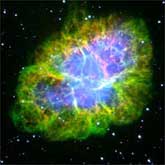Crab Nebula
 For millions of years a star shone in the far off constellation of Taurus. So far away, and so faint that even if our eyes were ten thousand times more sensitive, the star would still not be visible to us on the Earth. Then one day, in a few seconds, all that changed. An explosion beyond belief in its intensity lit up the heavens; it still shines, almost one thousand years later....
For millions of years a star shone in the far off constellation of Taurus. So far away, and so faint that even if our eyes were ten thousand times more sensitive, the star would still not be visible to us on the Earth. Then one day, in a few seconds, all that changed. An explosion beyond belief in its intensity lit up the heavens; it still shines, almost one thousand years later....
It begins about 30 million years ago, when a rather large star began to radiate. Because of its size, it was destined to live an abbreviated life (from a cosmic point of view!), compared to the 10 billion years or so that is allotted to our own Sun. As a reward, perhaps, it was also destined to go out in a blaze of glory, for 100 days rivalling the light output of our entire galaxy containing one hundred billion stars.
At the close of its existence, this star recycles itself into the fabric of our universe. It simply explodes, not from its surface as do other less massive stars, but from the very core of its central fire. We are still witnessing this explosion, 7000 years after it occurred.
About the Author
Chandra X-Ray Observatory Center
 The Chandra X-ray Observatory, previously known as the Advanced X-ray Astrophysics Facility, is a Flagship-class space telescope launched aboard the Space Shuttle Columbia during STS-93 by NASA on July 23, 1999.
The Chandra X-ray Observatory, previously known as the Advanced X-ray Astrophysics Facility, is a Flagship-class space telescope launched aboard the Space Shuttle Columbia during STS-93 by NASA on July 23, 1999.


